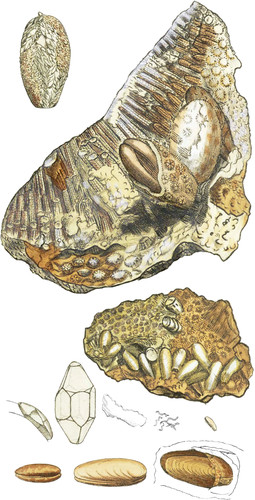 Enlarge
Enlarge
British Mineralogy
Coralloid Limestone
- Div. 2. Imitative.
Steeple-Ashton, Calne in Wiltshire, and the neighbourhood, afford vast quantities of Coral Rock, most of which has the common appellation of Coral Paste. It is frequently semi-transparent with a waxy appearance, and the Corals impregnated or cast in it often help the deception In well-chosen pieces it takes a fine polish, and often exhibits the structure of the Corals and other things which it contains, very beautifully, either like those found in Flint, tab. 291, or some other species, of which there seems to be a great number. The present specimens somewhat resemble, and are even more instructive than those from St. Peter’s mountain near Mæstricht, which seem to have been contained in a very similar stratum. It appears that the nature of these Coralloid Fossils has not been determined—see Parkinson’s Organic Remains, Pl. xii. 1. 2. This specimen shows that they ought to be considered as casts with regard to the Coral, which is evinced by the stellæ on the case of the Mytilus, which, for the sake of distinction, I shall call M. tunicatus. On uncovering some of these I found specimens sufficiently perfect to develop the truth, they having been often considered as Pholades, and lately as Alcyonia; but we must not allow of too much latitude for hypothesis.
The upper corner figure is one of the cased Mytili covered with remarkably formed crystals of Carbonate of Lime—see the outlines near the bottom of the plate—often having the facets, as on the outline below, mostly convex and rounding, and sometimes bending round or enwrapping the case like the left hand figure. This specimen has, in common with others, the granulæ that betray the Bath Limestone, tab. 8, and the partly Stalactitical Lime, as in tab. 1, of a very white colour, and paper-like form—see the middle figure of the second row from the bottom of the plate—or with the fibrillæ*, some tolerably distinct, and others very minute and very beautiful; these often resemble worms, and we occasionally find the remains of true Serpulæ, or a kind of worm-shell like those often found on oysters.
The large upper figure evidently shows great variety of casts; the Madrepore often forms six cordate appearances placed star-wise, with or without a column, and other whimsical deceptive appearances. The Mytilus has its dwelling among these, its case is variously ornamented with them, either as stars which arr the ends of the Corals, or as striæ, which are the sides of them. Within one of the coats the hinge end of the Muscle is very distinct. The Muscles are occasionally larger. The specimen below shows a number of smaller ones in a smaller Coral Both these specimens came from Calne. The lower bottom figure was taken out of a Steeple-Ashton turbinated Coral, the shell having the striæ and appearance of a fresh bivalve. The next figure is from one taken out of the small specimen, magnified; and the left hand one is a cast of Carbonate of Lime, such as is found within the shells, which determine them to he Mytili. This is covered with an Ochre, as are most of the specimens of Corals from Steeple-Ashton.
- * These, Mr. Parkinson thinks, argue against the stellated appearances being the remains of Coral casts; they are partly Stalactitical, produced since the formation of the Coral, and partly the casts of minute worm-holes.

